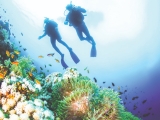Active tourism is becoming more and more fashionable and one of the reasons is because it allows you to discover a world of unique sensations. Release adrenaline and enter nature.
Recommendations for diving in underwater caves
To dive in caves we can go into flooded caves located in inland areas, but there are also underwater caves with direct access from the sea and, in other cases, they are located in areas close to the coast but without direct communication with it. (Water cave in Cartagena).

The main characteristic of this type of dive is that it is carried out under a real roof and, if a problem arises, it is not possible to exit directly to the surface.
Another important characteristic is the total absence of natural light, which requires them to be equipped with lighting systems. For this reason, the risk for the diver is high since any emergency that occurs underwater must always be resolved in the place where it occurs; prior training is necessary to be able to resolve any setback.
Before starting to practice this activity, it is advisable to take a specific diving course where you will acquire the appropriate knowledge and techniques. (correct installation of the guide line, characteristics of the equipment to be used, safety rules to follow, etc.) in addition to simulating the main incidents that may occur and how to solve them.

Modalities of cave diving
Diving in caves. Dives in cavities without exceeding 70 meters in length, not exceeding 30 m. depth, in addition to being dives without decompression and in which you are always seeing the exit.
Spelediving. Any immersion in a cavity that exceeds any of the limits established in cave diving or that, due to the peculiar characteristics of the cave, is not recommended for divers without adequate preparation (in some of them). These caves are warned of danger by informative signs). It is an extremely technical discipline, which requires extensive experience and the use of special equipment, in order to achieve certain objectives (such as beginning the exploration of an unexplored cave).
Precautions to take when diving in underwater caves
- Have prior knowledge and training in diving in underwater caves.
- Schedule and plan the dive in advance, gathering as much information as possible about the place where we are going to dive.
- Do not exceed the 70 m travel limit or enter decompression.
- Do not dive in caves without a guide wire, which must indicate the distance traveled and the direction of the exit.
- Use two independent regulators and, if possible, two independent equipment (two bottles with their corresponding regulator and pressure gauge each).
- Respect the air consumption limits, rule of 1/3 for the outward and two-thirds for the return and safety, therefore, there must be a 1/3 air reserve at the end of the dive.
- Take the two regulators next to your mouth.
- Carry enough light for the dive: three lighting devices per diver, each lasting longer than the dive time, equipped with a switch to use all of them alternately.
- Do not dive in caves prone to cloudiness (when lifting sediments from the bottom with the fins, detachments from the roof due to the bubbles expelled by our regulators, when landing on the bottom, etc.)

- Dive between two waters while maintaining correct buoyancy control.
- Do not dive in narrow galleries.
- In case of any doubt or incident, abandon the dive.
- There are a considerable number of caves in our country that are accessible to the majority of divers, but this does not mean that the safety measures mentioned above should not be ignored or any details left to improvisation.
Main causes of accidents in cave diving
Inexperience, lack of respect for safety regulations and recklessness can lead to accidents that, in this type of dives, can have fatal consequences. In a very high percentage of these types of accidents they are due to human errors and, in very few cases, to failures of some of the equipment elements.

Most of these accidents mainly depend on the following factors:
- Inadequate technical training for this type of dive.
- Incorrect use of the guide rope; abandon it during the course of the dive or the absence thereof.
- Incorrect air consumption management by not respecting the rule of thirds.
- Insufficient lighting: retracing a guide line without lighting can have fatal consequences for a diver not trained in this technique. Therefore, we must avoid overconfidence, never exceed our own limitations and not underestimate the risks; which will allow us to make pleasant and safe dives in places of such fascinating beauty.












